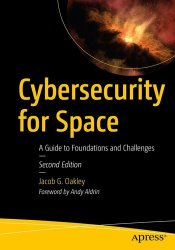 Название: Cybersecurity for Space: A Guide to Foundations and Challenges (2nd Edition) Название: Cybersecurity for Space: A Guide to Foundations and Challenges (2nd Edition)
Автор: Jacob G. Oakley
Издательство: Apress
Год: 2024
Страниц: 299
Язык: английский
Формат: epub
Размер: 10.1 MB
Space is one of the fastest growing military, government and industry sectors. Because everything in today’s world exists within or connected to cyberspace, there is a dire need to ensure cybersecurity is addressed in the burgeoning field of space operations.
This revised and expanded edition will prime the reader with the knowledge needed to understand the unique challenges to space operations which affect the implementation of cybersecurity. Further, the reader will have foundational knowledge on what impacts cyber threats can have on space systems and how cybersecurity must rise to meet them.
The author, who spent years in the United States Marine Corps, originally involved in satellite communications is now a seasoned cyber security practitioner who has provided cyber security vision and strategy to a large portfolio of systems and programs, many focused specifically in space. A published academic and experienced professional, he brings a practical, real-world and tempered approach to securing the final frontier.
Watchdogs are scripts or code that are triggered by various situational characteristics of the spacecraft to invoke a feature that will attempt to automatically solve whatever issue it was that triggered the watchdog. One example of a trigger and solution that a watchdog might involve could be a navigation issue where the onboard GPS of the satellite is failing to work properly. Without an ability to point accurately toward a ground station or a mission target, the space vehicle would essentially be dead in the water.
In such a scenario we would want the satellite to behave on its own in a way which might overcome the challenge of a defective or disabled GPS chip. Therefore, if after so long without an ability to read appropriate data from a GPS chip, a space vehicle may have watchdog code that forces it to start relying on some other form of pointing such as a star tracker or solar sensor. This way there is a chance the vehicle will be able to point back to a ground station and provide the operators of the space system with the information necessary to potentially fix or mitigate the broken GPS.
As an attacker, this means that any attack against navigation of a space vehicle must also account for the watchdogs that may be in place to try and save the space vehicle from such an issue. If the cyber attacker were only an insider executing commands from a ground station to disrupt the GPS, a watchdog may take over at some point and the operators of the space system may be able to regain control of the space vehicle. On the other hand, if a cyber-attack gained some access and privilege onboard the space vehicle’s computers themselves, outside of normal tasking, such watchdogs could be disabled. This could happen in a few ways. The attacker may delete the watchdog, change its trigger mechanism or threshold, or even alter the course of action taken by watchdog code.
What You Will Learn:
Basic concepts of how different space vehicles operate in general.
How such systems and their components integrate into cyberspace.
A clear picture of the potential damage available via cyber-attacks to such systems.
Basic efforts to mitigate such cyber threats will be presented through the various portions of space operations.
Foundational issues at the intersection of the space and cyber domains
Who This Book Is For:
This book is written for anyone curious about warfare in the era of cyber everything, those involved in cyber operations and cyber warfare, as well as security practitioners and policy or decision makers who are on the sending or receiving end of such activity.
Скачать Cybersecurity for Space: A Guide to Foundations and Challenges (2nd Edition)
|